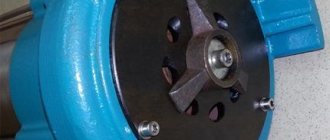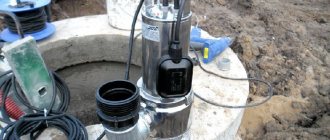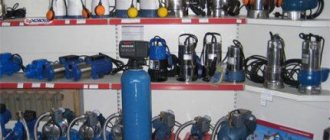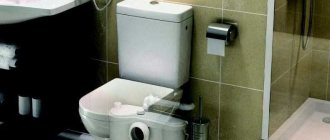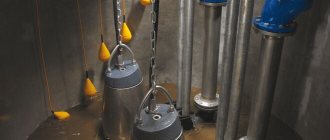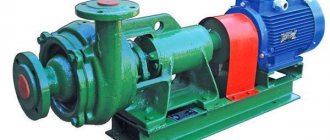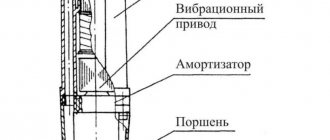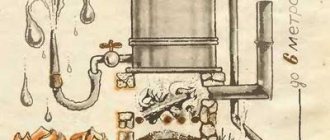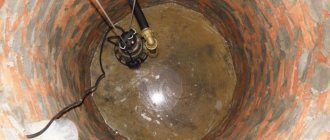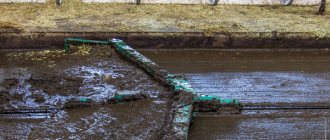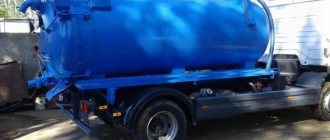When living in a private house, there are 2 options for pumping out sewerage: either you hire special services whose main task is to maintain an autonomous sewerage system or septic tank, or you do it yourself. Prices for specialist services force many people to stick to the second option, for which you will definitely need a sewer pump in a private house.
Features of underground drains
Before installing sewerage equipment in a suburban area, it is important to understand the structural features and functioning mechanism of underground drains.
The best drainage option for a summer house or country house is a cesspool or septic tank. In any case, silt deposits and various impurities will gradually accumulate here, which require periodic pumping. Even modern septic tanks do not always cope with the destruction of bacteria in waste, although they are quite expensive. Because of this, a cesspool remains an affordable and easy-to-maintain drainage option. For cleaning purposes, underground structures are equipped with an entrance for a sewage disposal truck or connected to a sewage pump, which allows you to carry out the necessary procedures independently and without the involvement of specialized equipment.
It is only important to first familiarize yourself with the rules and nuances of connecting cleaning equipment. Untimely cleaning of a cesspool can lead to serious problems, including the creation of unfavorable sanitary conditions in the area, harming the soil and human health.
Homemade products for small streams
A distinctive feature of this mechanism is its low energy consumption. There is no need for current and the depth of the stream can be minimal. The design is a swing with buckets attached on both sides, which need to be connected to each other by overflow.
To remove water from a stream, a drainage system is needed. It is made from galvanized steel. This material is lightweight and non-corrosive. Once made in this way, a pump for pumping water out of a shallow reservoir works as follows. The first bucket, when filled, outweighs and lowers. At the same time, the second one is emptied, rises to the drainage system, and takes the place of the first one.
It is necessary to make the design so that it can be configured at startup. To do this, you can use bucket attachments to the “swing”, which allow you to change the lever.
Purpose of the fecal pump
Silty and solid deposits do not evaporate, but accumulate on the walls of cesspools and the surface of the soil. They contain a large number of bacteria that infect people when using the toilet, as well as surrounding plants when they get into the soil. It is to eliminate sewage, maintain optimal sewerage operation and a favorable sanitary environment that fecal pumps are designed.
As the owner of a summer house or a private house, most likely you are already well acquainted with various types of pumping equipment, which is used to water the area and supply hot and cold water to the house, including for year-round heating. Sewage plants operate on a similar principle, pumping and then grinding sewage from a sewage facility.
It is worth noting that conventional water pumps are not suitable for such purposes: their impeller quickly becomes clogged with large particles from the wastewater, and therefore the electric motor may simply fail. It is special fecal units that are designed for efficient processing of solid waste, since they are equipped with a grinder that can cope even with particularly large-sized contaminants. High-tech models of such equipment are not cheap, so a homemade analogue can always come to the rescue, which will meet all the characteristics necessary to perform important work.
Fecal pumping device
In addition to its main purpose, this sewer pumping unit is also used on the farm for other purposes. For example, in case of flooding of the basement with groundwater. Using a fecal container, the pumping of water in the collection tank is organized. If it is used for pumping out thick masses, its operation can be fully automated by installing a float switch.
Also, fecal pumps make it possible to neutralize all the consequences of natural flooding from rain, melting snow and other natural phenomena in a country house or in a private house. The pump has a shredder in its design, so if minor debris or dirt comes across, there will be no negative consequences for it.
If you have organized a storm drain on your site, then a drainage-fecal apparatus is used to pump liquid from the collector sites. This is especially effective during seasonal heavy rains. Thanks to this, there will be no problems in these engineering networks.
Such units are successfully used when servicing artificial small reservoirs; then it is better to use a submersible pump for sewage. If there is a natural reservoir nearby, then summer residents use such a pump to irrigate their plots.
Drainage pumps are primarily used for pumping contaminated liquids containing small particles. To prevent the penetration of solid and large elements, a mesh must be installed.
When pumping out a thick mass (for example, it could be a sewage pit), a fecal apparatus is needed. A submersible unit with cutting mechanisms will fulfill its purpose, but this requires a sufficiently powerful pump that can cope with high loads.
What you need to assemble the pump yourself
The design of a homemade fecal pump is relatively simple. To begin with, you should familiarize yourself with the main components and their purpose, and understand the principle of operation of the equipment. To assemble it, you will need certain tools and parts, which can be found in inexpensive supermarkets for summer residents (and some, perhaps, borrowed from neighbors):
- a simple household submersible pump (it is best to choose a device of the “Kid” modification);
- metal slats;
- fine mesh;
- strong twine;
- welding machine.
Please note that when assembling a sewer pump yourself, you do not need to disassemble the base pump unit in an attempt to change its technical characteristics. The required functionality can be achieved by installing a filtration mesh on the inlet pipe, due to which the device will allow particles of solid impurities to pass through only the appropriate size.
Material
You can make vacuum pumps for pumping out sewerage with your own hands, since they do not have complex components. First of all, you need to prepare the materials and devices that will be needed for the work. They can be bought in stores or supermarkets. To work you will need the following:
- Submersible pump, model “Baby”.
- Several metal strips or rods.
- Mesh with small cells.
- Steel cable, strong cord or rope.
- Welding equipment.
Assembly and installation of equipment
To begin with, it should be noted that a homemade fecal pump is suitable exclusively for cleaning sewage drains in small private or country houses. In large buildings with a complex sewer system, it is still better to install professional equipment. Work on assembling the unit with your own hands should be carried out in the following order:
- Make a cage for the future pumping device by welding a steel frame from metal slats and stretching a mesh with small cells over it, which will act as a grinder. The mesh should not be too fine: the optimal cell size is 1x1 cm. Due to this design, the pumping equipment will not become clogged with large particles, and the unit will cope with all impurities without any problems.
- Tie strong twine or cable to the top of the cage.
- Place the pump in the cage and place it in the desired location.
Please note that the installation of the unit must be carried out strictly in the central part of the cesspool, otherwise the pumping equipment will not pump the sludge layers, but simply destroy them. In addition, with this arrangement, the device will be protected from clogging by fatty substances located on the surface.
To avoid failure of a homemade device, it is necessary to clean it monthly and replace the filter. To clean the fecal pump from fatty contaminants, it is enough to use hot water. Remove the pumping device from the pit and place it in a container with boiling water for 5-10 minutes. This time is enough to dissolve the fatty deposits.
Installing the device at home for a cesspool
If you plan to connect the pump for cleaning the cesspool permanently, then it is preferable to install PVC pipes instead of a soft hose.
In this case, sealing the connection is not necessary, but insulating the pipe to prevent freezing in winter is mandatory. In addition, it is advisable to install a check valve to prevent waste from flowing back into the pit after the pump stops operating, as well as a shut-off valve (installed in the pipe to preserve the sewage system). For successful operation of the pump in stationary mode (as well as in cases of unexpected power outages), an additional power source will be required - an electric generator (fuel - diesel or gasoline), equipped with an emergency shutdown system and grounding.
When installing the pump either permanently or for the period of a single cleaning of the cesspool, be sure to test the operation of the unit and adjust the shutdown level by the float sensor.
To do this, before launching, several test tests of the operation of the fecal pump are carried out using not wastewater, but ordinary water. It is at this stage of debugging and configuration that it is easiest to identify possible operational problems and eliminate them.
When purchasing a sewage pump, you should pay attention to the points below:
- possibility of installing the pump horizontally and vertically;
- pump size;
- engine power and other technical characteristics;
- ability to work at any temperature and in chemically aggressive environments;
- presence of a chopper, float beacon and control panel;
- country and manufacturer, availability of service.
By taking a responsible approach to choosing a fecal pump, you can always clean the sewer or cesspool with your own hands. The small size of the pump will allow it to be used even in the narrowest wells. A powerful engine will ensure stable and fast pumping of the most contaminated water. You can find out the sewer riser at the link.
Sample work of a semi-submersible sewage pump
Operating principle of a submersible fecal pump - photo
Sewage pump for cesspool
A pump for pumping sewage is quite useful equipment, especially for a private home. It is not always possible to ensure high-quality sewerage that works due to its independent flow. In this case, pumping stations come to the rescue.
High-tech, durable and reliable sewage pumps are expensive, so not everyone can afford such a purchase. There are models on the market from domestic and imported manufacturers. The price of devices starts from 10 thousand rubles, and this is the cost of not the most powerful and functional devices. To buy a truly worthwhile product for servicing a country mansion, you will have to shell out around 350-450 conventional units.
DIY sewage pump
But even if you don’t have the money for such an expensive purchase, don’t despair, because there is a way to make a sewer pump with your own hands. Of course, in terms of functionality it will be slightly inferior to professional devices, but as an alternative option it is very suitable.
Septic tanks or cesspools are used to collect and process wastewater in the area of country houses or dachas. Both require periodic pumping, since liquid waste is absorbed into the ground, and silt deposits and solid waste remain at the bottom and accumulate on the walls of the container, impairing the throughput of the soil.
Installation of a septic tank with a pump
Even if there is a modern septic tank on the site, consisting of several chambers, in which bacteria are responsible for processing sewage, sooner or later you will still have to call sewer trucks to clean the pit into which wastewater flows from the sewer pipe. The problem is that if it is not possible to drive up to the pit, then you have to look for alternative options on how to clean the drain tank.
Untimely cleaning of the septic tank can lead to serious problems associated with deterioration of soil throughput and the accumulation of large amounts of sewage in the pit. This is the overflow of wastewater onto the site, the spread of an unpleasant odor, the deterioration of the sanitary situation, which will certainly affect the health and well-being of the residents.
Operating principle of a hand pump
- First make a cage for the future sewage pump. To do this, metal slats are welded, and a fine mesh mesh is stretched along the perimeters on all sides. But do not use a mesh that is too fine. The best material is one where the cells are 1X1 in size. This is necessary to prevent the pump from clogging with solid waste.
- Attach a strong rope to the top of the cage, and the “Rucheyok” or “Baby” pump itself must be placed inside this cage.
- The cage with the pump is pulled up with a rope to such a level that the equipment is located exactly in the middle of the depth of the septic tank. In this case, the pump will not pump silt deposits (but only destroy them), and will not become clogged with fat that floats on the surface.
- To prevent damage to the pump, it is necessary to clean it monthly and then replace the filter.
Pump for home from improvised equipment
Note! You can clean a homemade sewer pump from greasy accumulations using hot water. To do this, you need to remove the equipment from the pit and place it in a container of boiling water for a few minutes. All fatty deposits will simply dissolve.
A homemade pump for sewerage maintenance is an excellent alternative to expensive purchased units. If you properly finish it, install it and provide proper care, such a device will do its job efficiently for a long period.
A bathroom in a private country house is an integral part of comfort, equal in convenience to a smoothly functioning autonomous water supply. Modern construction technologies make it possible to make this room as practical and furnished as in a city apartment.
However, it is the responsibility of the owners to ensure the proper operation of the entire sewer system. You can no longer rely on public utilities. Cleaning the sewer drain is entirely the responsibility of the owners living in the house. And to help cope with such a simple and at the same time very important task, special pumps designed for pumping sewage and fecal water are called upon.
Before purchasing a pump, you should pay attention to its technical characteristics:
- The case material determines the wear resistance of the device. Manufacturers produce units made of plastic, steel and cast iron. Stainless steel is considered the most reliable - it is resistant to aggressive environments and corrosion.
- Power is an important indicator that affects the performance of the unit. To determine this parameter, it is necessary to take into account the size of the cesspool. For small wastes it is absolutely not necessary to purchase powerful industrial models, which are characterized by high cost and energy consumption.
- Pressure is a technical characteristic that determines to what height the pumped liquid will be raised. The parameter entirely depends on the dimensions of the cesspool being serviced. It should be taken into account that manufacturers indicate the maximum pressure in the technical data sheet. During pumping it is always lower. Therefore, the pump is purchased with a reserve of maximum pressure.
- Cooling is another important parameter that determines how long the device can be used without turning off. Manufacturers offer two types of pumps - cooled by flowing liquid and cooled by oil already present in the engine system. The second type is considered more resistant to overheating, since the pumped liquid does not always have the temperature and consistency necessary for cooling (it may be too viscous).
We suggest you familiarize yourself with Fufanon against bedbugs: how to breed - Fufanon instructions
Owners often wonder what is better – a professional or household model? Any unit of this type has one purpose – pumping out fecal waste. You need to know how to choose a drainage pump for a well.
But the materials from which these devices are made speak in favor of industrial models.
Cast iron and steel are more resistant to aggressive environments, and they are also not afraid of accidental impacts. Industrial designs are more powerful and have greater productivity. They are equipped with a grinder for pumping out liquids containing large inorganic impurities such as fabric, paper and cellophane. The price for such models is, of course, higher.
Household pumps have most of the mechanisms and housing made of plastic. They are light and mobile - this is their main advantage. But the duration of operation will be somewhat shorter.
Pumps for pumping out feces have their own strict classification, which is also very important for making the right choice.
Based on their design and installation method, the units are divided into three main types:
- Submersible – models equipped with a float to automatically stop the engine when running dry. Made of steel to ensure resistance to aggressive environments (work in hot liquid). The device is lowered to the bottom of the pit below the water level. Can be used to remove drainage water from basements. The mid-price model has a power of 40 kW, lifts liquids 20 meters and is capable of pumping out up to 400 cubic meters per hour.
- Semi-submersible – float type models. The lower end with the pumping chamber is immersed in the liquid. The upper part with the engine remains on the surface, above the water level. The equipment is mounted on a float or raft made of moisture-resistant material. Such units are capable of working with water containing impurities up to 1.5 centimeters in size. They do not have shredders installed - these are classic household models that are in greatest demand among owners of private houses.
- Surface (vacuum) - mobile and inexpensive devices that clean cesspools using an intake hose. Pumps of this type are not equipped with waterproofing - in summer they cannot be left in the rain, and in winter, waste water residues easily freeze inside. It is recommended to use indoors or place it in a coffered chamber. They work at a depth of up to 8.5 meters.
Installation of a pump in systems with a septic tank
Installing a pump in sewer systems with a septic tank is also a simple and quick job that you can easily handle on your own. The assembled pumping equipment should be placed in the well immediately after completion of its arrangement. To create a minimum gap between the intake hole and the bottom of the treatment facility, special metal holders are used on the pump body. To ensure reliable and efficient operation of the device, you can hang it on a strong steel cable or use a special support structure.
As an outlet pipe, it is best to use a PVC pipe with a diameter of 6 to 7.5 cm, which is connected to the pump without sealing the connection. The use of a flexible hose is not allowed, since prolonged use of such a product can lead to clogging of the pipe.
To prevent backflow of waste after turning off the device, the pump must be equipped with a check valve embedded in the pipeline. If it is necessary to preserve the sewage system, for example, for the winter, an additional shut-off valve is installed. It should be located behind the check valve. Before leaving for a long time, this valve must be closed to distinguish between the fecal pump and external drains. If the outlet pipeline is planned to be used intensively in winter, it should be carefully insulated.
The pumping unit is connected through the electrical panel. The latter must necessarily include the following protective devices:
- grounding;
- circuit breaker;
- Remote Control;
- device for forced switching on and off of the pump.
In the event of frequent power outages in the house, it is important to take care to ensure the uninterrupted functioning of the pumping equipment. To do this, the device is connected to a gasoline or diesel generator of the required power.
How to choose
If you choose a pump for pumping out of a cesspool, then first of all pay attention to the following parameters:
- Power - performance, pressure, etc. depend on this characteristic. For a summer house, 500 W is suitable; for a home where regular cleaning is necessary, it is better to choose a pump with a power of 1.5 kW.
- Power supply – most equipment used in private homes operates on a 220 V network; more powerful models are connected to a 380 V network.
- Performance is the volume of wastewater that the pump is capable of pumping in a certain time. This indicator directly depends on the power; with a power of 500 W, 150 liters will be pumped per minute, and with 1.5 kW - up to 600 liters.
- Pressure is an indicator of the liquid pressure in the outlet pipe (measured in meters of water column). On average, the pressure for household pumps is 12-15 m of water column.
- Case material – metal or plastic.
- Availability of automation - when choosing, it is better to give preference to equipment equipped with float sensors.
- Protection against engine overheating - cooling is carried out by the liquid in which the housing is immersed; if its level decreases, the motor may overheat and fail.
- Another important parameter is the size of particles that can be pumped by this model.
Also, when choosing a pump, you need to look at the markings, if they indicate:
- numbers - model for pumping clean wastewater, the particle size of which is up to 5 mm;
- letter F – suitable for heavily polluted wastewater with particles up to 30 mm;
- the letter H indicates that larger fractions can be processed.
If you make the right choice, taking into account all the above parameters, you will receive a guarantee that the equipment will last a long time. A fecal pump can be used not only for pumping out a cesspool, but also for other purposes.
Important technical information should be studied. characteristics of the device for pumping fecal and other masses.
| OPTIONS | DESCRIPTION |
| Power | The ability to pump out fecal matter at a certain speed. For constant pumping, preference is given to a 1.5 kW motor. If periodic cleaning is expected, then it is better to choose a power of 0.5 kW |
| Performance | The ability of the installation to pump out liquid at a certain speed per minute. For example, a device for arranging drainage and sewerage with a power of 1500 W is capable of creating a speed of up to 650 liters per minute. The choice of this parameter depends on the intensity of wastewater accumulation. If it is low, then a heavy-duty sump pump is not needed |
| Pressure | An important parameter indicating the ability of the device to lift liquid from a certain height. For example, a self-made pump mainly has a low pressure. It is important to consider not only the vertical, but also the horizontal pumping section. As a result, the pressure depends on the previous pump performance |
| Housing material | It is preferable to purchase a device for cesspools made of steel (stainless). Especially if we are talking about its constant operation in a difficult environment |
| Cutting material | The pump used with a grinder for the garden or home allows you to pump out masses with solid and thick inclusions. Taking this into account, the cutting element must be made of good quality steel |
| Automation | Units with cutting mechanisms can be equipped with automation. For example, a submersible pump with a float. Additionally, a water sensor is installed, which sends a signal to the motor to turn it on/off |
| Brand awareness | When choosing a sewerage device for a private home, preference should be given to well-known manufacturers. The selected model must have service in your area |
We invite you to familiarize yourself with DIY crafts from napkins
Starting and setting up pumping equipment
As soon as all the work on installing the pipeline, assembling and installing sewage pumping equipment, as well as connecting to the power supply is completed, it is time to test the installed system. An important step is to regulate the level at which the automatic float switch will turn off the device in emergency situations.
Begin to gradually fill the cesspool or septic tank with water, adhering to the minimum liquid level allowed for this equipment. Continue to fill the tank slightly above the appropriate level. If the installation was completed correctly, the sensor will operate and the pumping equipment will start.
It is better to conduct several tests of the device to ensure its reliability and performance. If you find the slightest problem, return to the initial stage of work, checking that each step was performed correctly. If the tests are successful, close the receiving well. Now the sewer system is completely ready for operation.
Tips for use
In order for your household drainage pump to last as long as possible, it is important to follow several rules when servicing it:
- Once a month, remove the pump and check it for serviceability. For example, the quality of the pipe connection, electricity, etc.
- Check the blade mechanism from time to time.
- Household feces can become clogged with fat deposits. Therefore, it is recommended to rinse with hot water from time to time.
- Before lifting the pump, be sure to unplug it.
- Check the functionality of the automation once a week.
- Have an alternative power source, such as a generator.
- After carrying out maintenance, be sure to check the operation of the automation.
- Before starting the installation, clean water is connected and pumped. This will ensure that it is working correctly and correctly.
Design #2 - manual pump with direct spout
A very simple device for pumping water from a barrel or well. The advantages of this design: speed of assembly, low cost.
Required parts:
- PVC pipe d.50mm – 1 pc.;
- PVC coupling d.50mm – 1 piece;
- PPR pipe d.24mm – 1 pc.;
- PPR branch no. 24 – 1 piece;
- PVC plug d.50mm – 2 pcs.;
- piece of rubber, diameter 50mm, thickness 3-4mm – 1 piece;
- check valve 15mm – 1 piece;
- empty silicone bottle 330ml – 1 piece;
- tightening screw clamp – 1 piece;
- screw-nut or rivet – 1 piece;
- union nut no. 15 – 1 pc.
We begin the assembly of the entire structure with the manufacture of a check valve.
Construction of a check valve. We prepare a check valve from a Ø 50mm plug. We drill several holes around the perimeter of the plug Ø 5-6mm. In the center we drill a hole of suitable diameter for a screw-nut pair or rivet.
On the inside of the plug we place a rubber disk Ø 50mm. The disc should not rub against the walls of the plug, but should cover all drilled holes. We tighten it in the center with a screw-nut or rivet; a screw will not work.
If difficulties arise with materials or manufacturing, you can replace it with a factory-ready check valve.
Preparing the pump sleeve. The length of the sleeve should be commensurate with the depth of the well or container with water. We cut the PVC sewer pipe Ø 50mm to the required length, from the narrow end. We insert the newly made valve into the pipe socket. For reliability, we fasten it on both sides with self-tapping screws.
For the second end we prepare a plug with a pre-drilled hole Ø 25mm. This hole in the plug is made according to the diameter of the PPR pipe Ø 24. Great precision is not required, the plug serves as a sliding support.
Piston assembly procedure. Cut off the spout of an empty silicone container. Next, you need to heat the balloon and insert the sleeve into the PVC so that the diameter of the balloon exactly matches the diameter of the sleeve. Place the silicone can on the valve from the reverse side of the arrow (the arrow on the check valve shows the direction of water movement).
We cut off the excess balloon. We secure it with a union nut no. 15.
Pump rod design. The length of the rod should be 50-60 cm greater than the length of the sleeve. You need to heat one end of the rod and insert a check valve. The arrow on the check valve should point towards the inside of the stem. Until the pipe has completely cooled down, we tighten it with a screw clamp.
Final assembly of the pump. We insert the rod into the sleeve and attach a plug (sliding support) through the coupling on top. To top it off, we attach a 24mm PPR bend to the end of the rod pipe. All you have to do is connect the hose and you can pump water.
The pipe material can be any, and the cross-section is not necessarily round. It is important to select the appropriate piston for the liner
The outlet serves as a support for the hand. For convenience, you can take a tee and plug one side of it.
Design #3 - manual pump with side spout
The previous design has one, but significant drawback. The spout moves with the stem. This design is not much more complicated, but much more convenient.
The sleeve needs to be improved. Add a 50mm PVC tee to the design with a 35 degree bend. The tee must be inserted into the upper part of the sleeve.
In the rod, near the piston, we drill several large-diameter holes, the main thing is not to overdo it and not to disturb the rigidity of the entire structure.
The piston moving upward pushes the liquid into the outlet pipe. The top cover serves as a support for the piston rod
Now water will begin to pour into the space between the rod and the sleeve. When the piston moves upward, water will begin to flow into the spout.
